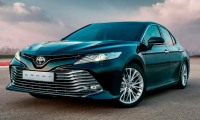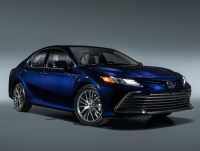The Toyota Camry is a Japanese brand sedan that is at the intersection of family and business class. The first generation was introduced in 1982 and has been consistently present in the Toyota model range ever since.
The current eighth-generation Camry, factory-indexed XV70, was introduced at the 2017 Detroit Auto Show.
The new model is radically different from its predecessor in design and driving mood. The car has become perceived as sportier and, along with the new 3.5 motor and 8-speed automatic, more dynamic. The interior design has also received a completely revamped design style. One look at the photos of the car, you know exactly - in front of us a completely new car.
Camry has a steadily high demand in the market and the appearance of the new model has provided the company with the first place in sales in its segment. In the market, the main competitors for the Camry 2019 can be called such models:
KIA K5;
Hyundai Sonata;
Volkswagen Passat;
Skoda Superb;
Ford Mondeo;
Mazda 6;
Subaru Legacy.
It is possible to buy a Toyota Camry 2020 for 29800$. For this money the buyer will get a car in the Standard package with a 2-liter motor capacity of 150 hp and a 6-speed automatic transmission.
New body of Toyota Camry 2020
The eighth-generation Camry XV70 is built on the new TNGA (Toyota New Global Architecture) modular architecture. The transition to the new architecture, according to the manufacturer's assurance, allows "to apply advanced engineering solutions and create more comfortable, reliable and safe cars." The Camry uses a variant of the GA-K platform, on which the Avalon, Lexus ES and RAV4 models are also built. High-strength and ultra-high-strength steels are used during creation of the body. It allowed reducing the body weight by 25% and at the same time increasing body torsional rigidity by 30%. To lighten the car and lower its center of gravity, the hood is made of aluminum and under it there is a force strut between the supports of front struts. Laser welding is used in body assembly.
The body design of the 2019-2020 Camry is completely new. The car became a little longer and wider, but also lower, the front and rear struts have a greater slope. The style is a bit reminiscent of the sixth-generation Camry in the XV40 body. All the exterior changes can be seen in the photo.
In the American market, there are two options for the front end - "sporty" and more "representative". For us, however, only the "representative" variant with a spectacular mouth with horizontal ribs is provided.
The front headlights are fully LED - dipped and high beam, daytime running lights, fog lights, turn signal. Only in the simple versions, the front turn signals and taillights with incandescent lamps (starting with Prestige Safety, the taillights are also LED).
Side mirrors are large, electrically adjustable, electrically folding, and turn signal repeaters in the housing.
In 2020, the company introduced a "sporty" S-Edition, which received two-tone body painting, bumper pads with red accents, a spoiler on the trunk lid, 18" special design rims and S-Edition emblems on the body. Toyota Camry is traditionally offered only with a 4-door sedan body. Its length is 4,885 mm, width is 1,840 mm and height are 1,455 mm. The wheelbase is 2,825 mm (+50 mm compared to its predecessor).
Toyota Camry is traditionally offered only with a 4-door sedan body. Its length is 4,885 mm, width is 1,840 mm and height are 1,455 mm. The wheelbase is 2,825 mm (+50 mm compared to its predecessor).
Despite the fact that the body itself became lighter, the curb weight of the vehicle compared to its predecessor has increased slightly. The reinforcement of the body and various equipment to improve safety make itself felt. Depending on the version and equipment, the curb weight is from 1570 to 1700 kg.
The trunk with the change of generations decreased slightly - to 493 liters. And in the versions Lux Safety and Executive Safety it is even less - 469 liters (because of the electric rear seat backrests). The electric trunk is not provided.
Engine and transmission Toyota Camry 2020
Only gasoline engines are offered on the market for the new model. Two of them, proven four-cylinder engines, are inherited by the newcomer from its predecessor. The design has a variable valve timing mechanism on the intake and exhaust, the fuel injection is distributed. These engines are combined with the same proven, but improved for the new model, six-speed automatic. A new 3.5-liter V6 is also offered, which is paired with a new 8-speed automatic transmission. Front-wheel drive.
The base 2AR-FE 2-liter engine develops 150 hp at 6,500 "rpm" and maximum torque of 192 Nm is reached at 4,700 rpm. It is combined with a 6-speed automatic transmission.
A more powerful alternative is the 2.5-liter 6AR-FSE four with 181 horsepower (6,000 rpm) and 231 Nm of torque at 4,100 rpm. It also comes with a six-speed automatic.
The most powerful engine is the all-new 2GR-FKS. V-shaped 6-cylinder, 3.5 liters. It was especially de-energized up to 249 hp to reduce taxation. The torque is 356 Nm at 4,700 "rpm".
Suspension, brakes and wheels of the 2020 Toyota Camry
A completely new suspension has been developed for the GA-K platform. The suspension is independent with McPherson struts at the front and independent multi-linkage at the rear.
The new suspension provides a good balance between drivability and smooth ride. For the sake of lower center of gravity, they even reduced the clearance to 155 mm (-10 mm). The Camry copes with small irregularities nobly, although with the growth of speed road irregularities get into the cabin more appreciably. Suspension is power-consuming and, as a whole, surpasses competitors in smoothness of drive. At overdrive in a corner, it starts to slide predictably with all four wheels.
Steering is much sharper and more responsive, with linear, reactive action. The electric power steering is now located on the steering rack rather than the shaft.
The brakes are disc brakes on both axles, ventilated at the front. The braking distance from 100 km/h until a full stop is less than 37 meters. There is already ABS, Brake-force Distribution System (EBD) and Brake Assist System (BAS) in the basic configuration.
Camry, depending on the version, is equipped with 16-, 17- and 18-inch alloy wheels. Each wheel size has a different design. Tire size is 205/65 R16, 215/55 R17 and 235/45 R18, respectively. A full-size wheel with an alloy wheel is used as a "spare" wheel.
Toyota Camry 2020 interior
The five-seat Camry interior has received a completely new design. Soft plastic, matte inserts "like wood", fabric and leather are used in interior design. Visibility is excellent - thanks to the high seating position, the large windshield and thin front pillars.
Visibility is excellent - thanks to the high seating position, the large windshield and thin front pillars.
The upper part of the front panel with flamboyant lines is now turned towards the driver. In the simpler versions, the multimedia system has a 7" touchscreen. The more expensive ones will have the Toyota Touch 2 system with an 8" screen with navigation and all-around vision (4 cameras). Unfortunately, integration with Apple CarPlay, Android Auto or Yandex.Auto is not provided at the moment. Of course, there is Bluetooth, USB and audio jacks, as well as a 12V socket for powering various devices and equipment. The controls for the dual-zone climate control (already in the basic package) are located a little lower.
In addition to the leather-trimmed transmission lever, the center tunnel has a pair of cup holders, a niche for wireless smartphone charging (an option for the entry-level versions), and an electronic parking brake button. Large center armrest with leather trim.
The instrument panel with two analog wells is well readable, all thanks to the white backlight and optimal fonts. Between the speedometer and tachometer, depending on the version, there is a 4" or 7" high resolution color screen. The most expensive Executive Safety version has a projection dashboard on the windshield.
The steering wheel with function buttons is slightly reduced. Using the buttons on the steering wheel you can control the audio system, cruise control and receive calls. For the market, all versions, even the base one, have a leather steering wheel upholstery. Almost all versions have mechanical tilt and telescoping adjustments, only the Executive Safety version has an electric drive. Heated steering wheel begins with the Elegance Safety version.
The front seats are soft, with a wide cushion and not the most pronounced side support. Adjustment range is very high, even tall drivers will be able to sit comfortably, despite the fact that the seats themselves are set lower. In the basic versions, the adjustments are mechanical, but starting with the Classic version is available electric adjustment of the driver's seat in 8 directions and lumbar support adjustment for the driver. Depending on the version, the seats can be upholstered in fabric, dark or light leather. Heating of the front seats is already in the base. Ventilation is only available for the richest version.
The rear sofa is also set lower than its predecessor. There is enough space for knees and above the head - after all the base has increased by 5 cm. But there could be more space for feet, especially if a taller person sits in front, who has lowered a seat to the lowest position. The central tunnel noticeably steals the space for the middle passenger. The backrest of the sofa is adjustable for inclination. There is a hinged armrest with two cup holders, ventilation deflectors above the central tunnel and two sockets. In the simple versions, the backrest folds down in the 40/60 ratio. The more expensive Lux Safety and Executive Safety versions offer two split rear seats with electrically tiltable backrests. They fold down in a 40/20/40 ratio. For these versions, the reclining armrest is equipped with a control box with touch buttons to control the 3-zone climate control, audio system, backrest tilt and heating.
Noise isolation is good - at city speeds the Camry is quiet. With the growth of speed there is noise from tires and wind in the area of the center pillar and side mirrors. The version with a 3.5 engine feels quieter, as the younger versions need to "twist" to high revs more often.
The "Winter Package" includes such features:
heated steering wheel;
heated front seats;
heated rear seats;
heated side mirrors;
electric heated windshield washer nozzles;
heated windshield in the windshield wipers' resting zone;
electrically heated windshield;
air ducts for the second row of seats;
low washer fluid indicator.
Toyota Camry 2020 safety systems
The eighth-generation Toyota Camry passed the 2018 crash tests of the U.S. Insurance Institute for Highway Safety IIHS. It received the best possible score (Good) and the TOP SAFETY PICK+ title on all parameters.
Active safety systems:
anti-lock braking system (ABS);
Brake-force distribution system (EBD);
Brake Assist System (BAS);
Traction control system (TRC);
Vehicle Stability Control (VSC+);
hill assist (HAC);
blind spot monitoring system with visual alert function (BSM);
reverse parking assist with visual and audible warning (RCTA);
rear view camera;
all-around view camera (Executive Safety);
cruise control.
Toyota Safety Sense 2.0 active safety systems:
Traffic Sign Recognition and Driver Information System (RSA);
Lane Departure Warning (LDA) system with Lane Departure Assist (LDA);
driver fatigue monitoring and information system;
frontal collision warning system with automatic braking and pedestrian recognition (PCS);
cruise control with the function of maintaining a safe distance to the vehicle in front (DRCC);
automatic high beam to low beam (AHB) system.
Passive safety systems:
front and side airbags;
curtain airbags;
side airbags for first and second row seats;
driver's knee airbag;
front seat design to reduce neck injuries (WIL technology);
ISOFIX child seat mounts.
Warranty and service of Toyota Camry 2020
All Toyota vehicles are warranted for 3 years or 100,000 kilometers of mileage. No through-corrosion and paintwork warranty for 3 years. Warranty on spare parts and accessories 1 year. Service mileage is 10 thousand kilometers.




